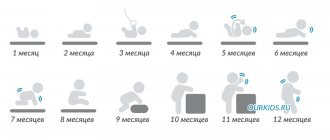Why is your daily routine so important?
Why is the daily routine important? The baby grows very quickly and develops rapidly; every month he develops new skills, interests, abilities and preferences. And so that a child can explore the world actively and harmoniously, he needs to be helped in this. And this is precisely why a daily routine is needed.
If the baby performs certain actions according to the schedule, he will feel protected. The regime is a kind of ritual lasting the whole day. The procedures are performed in a certain sequence and at approximately the same time, which forms habits and once again proves that everything is in order, there are no drastic changes or unfamiliar situations.
By observing the daily routine, the child gradually learns discipline and becomes organized. This will be very useful when the baby starts attending kindergarten, where all actions are carried out strictly according to the schedule. It will be easier for the child to wake up and fall asleep at the same time, and eat food at certain intervals.
But the regime is also very useful for parents. If a mother knows what her son or daughter will do and when, then she is calm, organized and not in a state of stress or misunderstanding due to ignorance and inconstancy. Parents have free time, because if you build a routine taking into account the needs of the whole family, you can find time intervals for your own affairs.
Disturbances in daily routine
Very often, disruptions to the daily routine occur when the child is sick, teething, or for other reasons. Sometimes when traveling when traveling by plane, your usual routine also gets disrupted. It’s okay, gradually the baby will return to normal and restore its usual routine.
If the baby is out of order
It happens that the baby is healthy, but it is not possible to put him to bed on time. Parents should analyze all events and look for the reason for this behavior. There are different reasons:
- Sometimes the child does not get very tired, so you need to add active games with elements of physical development.
- In other cases the situation is the opposite. The baby cannot fall asleep due to overexcitation. In this case, it is recommended to exclude active fast games some time before bedtime.
A one-year-old child’s routine is very important for his development and full growth. When planning your day, it is important to take into account not only the characteristics and wishes of the baby. You need to create a daily routine so that the baby is comfortable, but at the same time it also suits the parents. According to the famous pediatrician Evgeniy Komarovsky, adults need a daily routine more in order to streamline their lives; the baby, in principle, doesn’t care.
What changes in a child’s daily routine at 1 year old?
The daily routine of a baby at the age of one year is not very different from the routine at 11 months, as well as at 1 year and 1 month. A one-year-old baby experiences the same needs for physical activity, emotional and intellectual development, nutrition and sleep. Nothing fundamentally new appears in the daily schedule.
The only thing that can undergo changes is sleep. It can be either twice or once per year. If the baby wakes up early and is tired after active morning activities, he simply needs rest to restore strength and “reboot” the brain. If the baby doesn’t wake up very early, and his nervous system is strong enough, then he can easily sleep once: a single sleep will be enough to rest, replenish energy reserves and assimilate the information received during the first half of the day.
How do you know what kind of sleep is right for your baby? Take into account his habits and needs, watch him. If by lunchtime the baby begins to be capricious and rub his eyes, and also looks lethargic and tired, then it will probably be useful for him to rest in the morning. If the child is calmly awake and does not show signs of fatigue, then one afternoon nap will be enough, especially if the son or daughter goes to bed at night not very late.
Daily routine for a 2 year old child
- Dream. At this age, a child should sleep 12–13 hours a day, of which 10–11 hours at night and 1.5–2.5 hours during the day.
- Wakefulness. A 2-year-old child can stay awake actively, without overwork, for 4.5 – 5.5 hours. As always, these averages can be adjusted to suit your individual needs. In addition, after illness or against the background of high fatigue, the child’s periods of wakefulness may be reduced, and the time of necessary sleep, on the contrary, may increase. Longer sleep allows you to restore strength, increases the body's protective barrier and relaxes the nervous system.
- Walks. As before, children spend part of their waking hours outdoors. The baby continues to work on coordinating movements, which become more dexterous and accurate. Physical activity becomes more varied, the child is now generally more mobile than at the age of one to two. To prevent the baby from becoming overexcited (which always affects mood, speed of falling asleep, quality of sleep and its duration), parents should regulate the child’s vigorous activity on the street, offering him activities of varying intensity: running, playing in the sandbox, climbing slides, riding on a swing. But it is also impossible to limit physical activity with your prohibitions (even if they are related to safety issues), since this imperceptibly but steadily leads to a decrease in the child’s emotional tone, bad mood, dissatisfaction with the world around him, the baby gets tired faster, becomes whiny, and irritable.
- Games and activities. Nursery-type preschool institutions include in their schedule no more than 10 lessons per week (development of speech, movements, didactic games, music or dance minutes) lasting no more than 10 minutes. This schedule can be used to build your home schedule of developmental activities. Drawing, reading books and looking at pictures, construction sets, story games, dolls and houses for them, farms and animal figurines, puzzles, insert frames - this is a favorite set of games and activities for all children of this age, which in themselves can be educational if an adult will include a cognitive element in them and “modify” them a little (for example, compose a story based on a picture in a book).
- Nutrition. In the third year of life, a child’s diet becomes more and more varied and in many ways approaches the adult diet (of course, if the family adheres to the principles of healthy eating). The daily regimen for this age includes 4 feedings a day with an interval of 3.5 - 4 hours (breakfast, lunch, afternoon snack and dinner). Some children find it difficult to withstand such long breaks without food. In these cases, healthy snacks are acceptable: a glass of baby kefir or baby yogurt.
- Hygiene and rituals. Teaching hygiene skills continues to be the most important routine at this age. Formed in time, they become good habits for life. Washing, washing hands, brushing teeth, using a napkin and utensils during meals, being neat at the table - the baby can already independently regulate all these actions.
Mandatory components of the daily routine of a one-year-old baby
What should a 12 month old child absolutely do during the day? Its schedule includes the following components:
- Dream. Can be single or double.
- Meals. The number of feedings is six times.
- Walks in the open air.
- Understanding the surrounding world and various phenomena through educational activities and games.
- Physical activity. These are active games that allow you to splash out energy and emotions.
- Hygiene procedures: washing, brushing teeth, taking a bath.
Daily routine: table by hour
The baby's daily routine per year will include all the activities listed above. The sample schedule table below clearly shows what a schedule might look like with two naps during the day:
| Time intervals | Actions and procedures |
| 6 a.m | Waking up after a night's sleep. Morning hygiene procedures (washing), as well as changing clothes. |
| From 6:15 to 6:30 | First feeding: either breast milk or formula. |
| From 6:30 to 7:30 | Games in quiet mode. |
| From 7:30 to 8:30 | Gymnastics, massage, communication. |
| From 8:30 to 9 | Breakfast. |
| From 9 to 11 o'clock | First morning dream. It can be combined with a stroller walk in the fresh air. |
| From 11 a.m. to 1 p.m. | Various games or educational activities with the parent. |
| From 13:00 to 13:30 | Full lunch. |
| From 13:30 to 15 hours | Fun joint games with mom and other family members, physical activity. |
| From 15:00 to 16:30 | The second walk, during which you should play actively, look at different objects on the street. |
| From 16:30 to 16:45 | Afternoon snack. |
| From 16:45 to 18 hours | Second dream. |
| From 18:00 to 18:30 | Waking up, changing clothes, communicating. |
| From 18:30 to 19 hours | Dinner. |
| From 19:00 to 20:30 | Calm, inactive entertainment. For example, communication, reading books, looking at pictures. |
| From 20:30 to 21 | Bathing before bedtime, changing clothes, relaxing massage, brushing teeth and other hygiene procedures, as well as bedtime ritual. |
| From 21:00 to 21:30 | Last feeding at night. |
| From 21:30 to 6 o'clock | Night deep sleep. |
And this table shows a sample regime for a baby who sleeps once a day:
| Time intervals | Actions and procedures |
| 6 a.m | Waking up after a night's sleep. Morning hygiene procedures (washing), as well as changing clothes. |
| From 6:15 to 6:30 | First feeding: either breast milk or formula. |
| From 6:30 to 7:30 | Games in quiet mode, development. |
| From 7:30 to 8:30 | Gymnastics, massage, communication. |
| From 8:30 to 9 | Breakfast. |
| From 9 o'clock to 11 o'clock | Games at home. |
| From 11 a.m. to 12:30 p.m. | Getting dressed, walking in the fresh air. |
| From 12:30 to 13 o'clock | Changing clothes, communicating. |
| From 13:00 to 13:30 | Full lunch. |
| From 13:30 to 16:30 | Daytime long single sleep. |
| From 16:30 to 17 hours | Changing clothes, communicating with a parent. |
| From 17:00 to 17:15 | Afternoon snack. |
| From 17:15 to 17:30 | Dressing, socializing. |
| From 17:30 to 19 hours | Walk outside. |
| From 19:00 to 19:15 | Changing clothes. |
| From 19:15 to 19:45 | Dinner. |
| From 19:45 to 20:30 | Quiet entertainment: playing with toys, looking at pictures, reading books, talking. |
| From 20:30 to 21 | Bathing before bedtime, changing clothes, relaxing massage, brushing teeth and other hygiene procedures, as well as bedtime ritual. |
| From 21:00 to 21:30 | Last feeding at night. |
| From 21:30 to 6 o'clock | Night deep sleep. |
The tables indicate approximate hours. All children are different: some wake up earlier, others later. It is worth starting from the time of natural independent awakening when planning your daily routine. Follow the intervals shown above.
Possible problems
Sometimes at the age of one year, mothers notice the so-called sleep regression. That is, a baby who previously fell asleep easily and did not experience any other difficulties begins to throw tantrums before going to bed, and also sleeps lightly and lightly.
The most common problems parents face are:
- the child refuses to fall asleep - cries, is capricious, rubs his eyes and clearly wants to rest;
- the baby does not want to go to bed at the time at which he is used to, remaining alert;
- the baby wakes up all night, sleep is light and superficial;
- A 1 year old child sweats a lot in his sleep.
Indicators of temperature and humidity in the room. Why are they so important?
The answer is simple: if it’s hot, the mucous membranes dry out, it’s harder for the baby to breathe, he sweats, clothes rub, in general, an uncomfortable condition develops, in which it’s impossible to sleep deeply. The normal indicators are 18-20 degrees and 50-70% humidity.
In addition, it is important to ventilate the room well before going to bed. So that the mother does not worry that the baby will freeze, he should be dressed warmly. The latter is also true for those babies who do not want to sleep under the blanket and throw it off all night.
The ideal place for a one-year-old child to rest is in his own bed, not in his parents’ bed. Mattress, bed linen, sleeping clothes - all this must be of high quality.
Even the powder is important (toxic ones are difficult to wash out, and the fabric emits a strong chemical “aroma”). All linen must be cotton. Sometimes poor sleep is caused by health problems.
Teeth cutting, neurological diseases, discomfort in the tummy - these are the things that worry babies most often. If you suspect such problems, you should consult a specialist.
According to children's specialists, at this age the child experiences a real shock, which can have a bad effect on sleep. And this stress is associated with mastering a new skill - confident walking, and therefore expanding opportunities for exploring the surrounding space.
Having learned to stomp on his own, the baby wants to do it all the time - sleep becomes boring and uninteresting! It may take the baby from one to several weeks to understand the new self.
Sleep Features
Sleep plays a very important role, so it should be given special attention. And there are several most important points. Firstly, the duration of a baby's sleep per year is a total of about 13-14 hours. The baby sleeps for about 9-10 hours at night, and the rest of the time during the day.
Secondly, attention should be paid to styling. Some babies fall asleep on their own, and these babies can simply be placed in their crib. Others need help to relax, adjust to rest mode, and process the information received during the day. If your son or daughter does not fall asleep on his own, think over and perform a certain ritual - a sequence of actions. For example, this could be eating, changing clothes, reading a book or singing a lullaby, moving to a sleeping place, hugging or holding hands.
Thirdly, it is worth remembering that not all children sleep continuously throughout the night without waking up. Some people wake up once, while others get up several times. But it is important to show that you need to continue sleeping: do not turn on the light, do not entertain the child. If crying is intense, offer water, breast or formula.
Features of the regime for children from one to three years old
Children at this age experience any changes especially acutely. Therefore, parents need to accustom their baby to a daily routine as early as possible. However, this should be done gently and gradually.
Advantages of the mode:
- the child learns to be organized;
- the functioning of internal organs is normalized;
- the baby becomes calmer;
- adaptation to the nursery is easier.
If, for some reason, parents were unable to accustom their child to organizing the day before the age of three, then in the future it will be much more difficult to do this. How to accustom a 5-year-old child to a routine will be discussed in the next section.
Nutritional Features
During the baby's year, it is still recommended to breastfeed or use an adapted formula. But breast milk or formula is no longer the main food. It is also important to include other foods in the diet that ensure that the child’s body receives the necessary nutrients. At one year old, the baby eats much less often than in the first six months of life. He eats 6 times (with milk feedings). Portion sizes also increase to take into account the needs of a growing body.
A one-year-old child has about 8-10 teeth, so chewing skills can be developed. To do this, offer not only pureed food, but also soft food in small pieces (1-1.5 cm in size). These can be fresh or thermally processed non-solid vegetables and fruits. You can also give baby cookies and bread.
What foods should be included in the diet
The baby's diet per year should be varied, complete and balanced. The diet includes the following products:
- Breast milk or formula. The daily volume is no longer large; you can leave only two feedings: the morning after waking up, and the evening before bedtime. But milk or formula can be offered for an afternoon snack.
- Cereals: wheat, corn, buckwheat, rice, barley. Cereals are offered in the form of porridges, baked goods and pasta.
- Eggs: either chicken or quail. First, the yolk is given, then the white is gradually introduced.
- Meat: beef, rabbit, veal.
- By-products (beef): liver, tongue, heart.
- Poultry: turkey, chicken (if there is no allergy).
- Vegetables, melons, root vegetables: carrots, potatoes, different varieties of cabbage, zucchini, beets, pumpkin.
- Fruits and berries: pears, plums, blueberries, apricots, apples, peaches, raspberries. They are given fresh, in puree, compotes. Citrus fruits are not offered per year. Red berries and fruits are excluded in the presence of allergic reactions.
- Fermented milk products: yoghurt, cottage cheese, hard cheese (lightly salted).
- Cow's milk.
Menu
Let's look at the daily menu for a one-year-old baby in the table:
| Eating | Food |
| First appointment | Formula or breast milk. |
| Breakfast | Dairy-free or milk porridge (can be with butter), half an egg, some fruit if desired (can be added to the porridge), juice. |
| Dinner | Vegetable dish (soup, puree, stew), vegetable oil, meat or fish (in the form of steamed meatballs or cutlets, soufflé), a piece of bread, juice. |
| Afternoon snack | Cottage cheese, fruit, children's cookies, kefir/milk. |
| Dinner | A vegetable dish (can be with pasta), a little vegetable oil, fish or meat, juice or compote. |
| Last meal | Breast milk or formula. |
Norms, portion sizes and volumes of food consumption
How much should a one year old child eat per day? To determine the norm, you can divide the baby’s body weight by 8 or 9. On average, a baby weighing 10-11 kilograms will eat from 1100 to 1300 grams per day.
Now let’s look at the consumption standards for individual products:
- Breast milk or formula – up to 300-400 ml.
- Porridge – 200 g.
- Vegetable puree – 200 g.
- Fruit puree – 110-125 g.
- Fruit children's juice - about 100 ml.
- Fermented milk products – up to 200 g.
- Meat – 70-80 g.
- Fish - about 60-70 g.
- Cow's milk - no more than 150-200 ml.
- Cookies, children's crackers - 10-20 grams.
- Wheat bread – 10-15 grams.
- Vegetable oil – 5 g (teaspoon).
- Butter – 5 g.
- Egg – 50-60 g (half a chicken egg).
How long does a child sleep between 1 and 4 years old?
1 year. A child usually sleeps about 14 hours a day, of which 11–12 hours occur at night. With one daytime sleep, the period of wakefulness is 5 hours, with two - about 3 - 4 hours.
It is also important to remember about the quality of sleep: experts recommend putting your child to bed at night no later than 21:00. Deep sleep 3–4 hours before midnight perfectly restores strength, normalizes the functioning of all body systems, and energizes. The number of awakenings per night can be significantly reduced if you teach your baby the skills to fall asleep independently.
If at 1 year of age your child finds it difficult to transition from two sleeps to one, the second of them usually begins in the late afternoon and bedtime is postponed until later, use this advice: try introducing a flexible sleep schedule. Let the child sleep twice on some days, once on others. This is normal for the transition period. Be patient and your sleep patterns will return to normal pretty quickly.
1.5 years. The child sleeps approximately 12 – 14 hours. By this age, most babies switch to one long daytime nap of 1.5 - 2 hours. The optimal wake time before bedtime is 5–6 hours.
A good mood throughout the day will ensure your baby gets a good night's sleep lasting 10-12 hours. Be sure to pay attention to ensure that the baby is not tired before this. Going to bed too early leads to a long process of falling asleep. Try to find an ideal bedtime for your baby between 7:00 pm and 9:00 pm.
If you notice that after several months of good sleep, your one-and-a-half-year-old child suddenly begins to wake up frequently and takes longer to fall asleep, he most likely has a temporary sleep regression, which is caused by another growth spurt.
There are several such periods in the first years: they usually occur at the ages of 4 and 8 - 10 months, 1.5 and 2 years. Try to prevent bad sleep habits from becoming ingrained: falling asleep with a bottle, drinking sweets at night. Your patience, adherence to the daily routine, avoidance of excessive emotional stress and overwork by the time of evening bedtime - and your baby's night's sleep will be strong and healthy.
2 years. Daily sleep for a 2-year-old child is 12–14 hours, of which 1.5–2 hours are daytime rest.
- It is still important for babies to get enough sleep at night to recharge all body systems. One or two awakenings per night are within normal limits. More frequent awakenings indicate more of a developed habit than a physiological need.
- Mothers note that their 2-year-old child’s sleep is improving. This is due to the fact that the brain and nervous system are developing, the baby is actually able to sleep better than during infancy.
- The quality of a 2-year-old's nighttime sleep may be impaired if the baby sleeps too much during the day. But more often at this age, another phenomenon is observed - refusal of daytime sleep, associated with the next stage of development and growth spurt. The child refuses to go to bed during the day, takes a long time to go to bed in the evening, and while going to bed constantly tries to escape.
Nevertheless, the need for daytime sleep in children of this age remains. One-time absences are acceptable here, but the final transition to a regime without daytime rest can lead to the accumulation of fatigue and deterioration of night sleep.
Periods of no napping usually last several weeks. Try to show restraint, calmness and consistency, continue to follow the regime and focus on the age-specific sleep norm.
What can be done?
- Move developmental activities to the morning hours.
- Calm down yourself: the child will feel your tension and desire to leave the children's room as quickly as possible during the tedious daytime bedtime and will try in every possible way to prevent this.
- Follow the routine, don’t forget about the bedtime rituals (daytime rituals should be different from evening ones - you’ll have to come up with something else for this case - for example, a quiet game with dolls or a construction set will do) and give your baby as much attention as necessary.
2.5 years. Two-year-old children need an average of 12 - 13 hours of sleep per day: about 1.5 - 2 hours during the day and about 11 hours at night.
If the child finally refuses daytime rest and none of your countermeasures work, he should take the entire daily sleep requirement at night.
The main indicator that a child is ready to do without naps is his good and even mood throughout the day. No whims, sudden tears, bursts of hyperactivity, lethargy during the afternoon or early evening. The baby wakes up with a smile, spends the day actively, and goes to bed happy.
It’s good when a child can wake up on his own in the morning. If he is already in kindergarten and you have to wake him up regularly and early in the morning, evening bedtime needs to be moved to an earlier hour.
3 years. Total daily sleep is about 12 hours. With this amount of sleep at night, children can already do without daytime sleep, however, if the norm is not achieved overnight, the child may need rest during daylight hours. The daily routine of preschool institutions includes a mandatory daytime nap of 1.5 hours, and many children, having given up this “habit” at 2–2.5 years, easily return to it.
Indicators that a child can do without naps:
- Smooth cheerful mood throughout the day;
- Getting up independently with a smile and in a good mood;
- Sleep at least 12 hours at night.
The main characteristic of this age is the so-called crisis of three years: parents observe in their child manifestations of negativism, stubbornness, obstinacy, despotism, self-will, a tendency to protest and rebellion, and devaluation of the opinions of adults.
The child increasingly strives for independence, independent actions from adults. At the same time, the baby still needs support and care from the parents. Therefore, despite the fact that his desire for independence extends to issues of regime, mom and dad need to show the firmness expected of them and consistently follow a healthy daily routine.
To avoid turning bedtime into a war, start getting ready for bed early so that your baby has the opportunity to gradually calm down and go to bed voluntarily. A timer, dim lights, quiet games are a clear signal for the child that it’s time to get ready for sleep.
4 years. The baby still needs 11 - 12 hours of sleep per day. If the child continues to sleep during the day, then the duration of this rest is reduced to 1 - 1.5 hours.
Typically, between 3 and 7 years of age, an important change in daily routine occurs—the final abandonment of daytime naps. Therefore, maintaining a routine with sufficient time for night rest is very important at this stage. What should you pay attention to?
- Difficulties may arise with getting to bed, especially if the family does not have well-established evening rituals. It is necessary to begin preparing for bed in advance, allowing the child to calmly finish the game he has started - this way he will have the opportunity to gradually calm down and go to bed voluntarily.
- Going to bed is painless if in the evening the child begins to feel physically tired. However, it is important not to confuse this condition with emotional overload. The baby needs active games, but there should not be excessive emotional fatigue: this will interfere with good sleep.
- Most children at this age are not yet able to adequately assess their condition, so parents may not hear: “I’m tired, it’s time for me to sleep.” Instead, they observe whims, crying, bursts of hyperactivity, anger and aggression. Parents are required to pay close attention to such manifestations: most likely, they signal fatigue, and, therefore, the daily routine needs to be revised.
Try negotiating bedtime routines with your older child, such as setting a timer to end a game before bed or using an alarm clock as a wake-up signal. Follow your usual rituals, act confidently and consistently, and don’t forget to watch for signs of fatigue.
As a rule, children of this age are already quite ready to sleep in a separate bed and even in a separate room. It's time to talk about sleeping independently in a crib.
Skills of a one-year-old child
What should a 1 year old baby be able to do?
- Stand confidently, walk (optional), crawl, sit.
- Rise to your feet from any position, squat and stand.
- React to relatives.
- Respond to name.
- Confidently hold and grasp objects.
- Pronounce syllables or simple monosyllabic words.
- Try to climb or climb onto low objects, or get off them.
- With the help of adults, assemble simple pyramids.
- Point to objects.
- Build small towers.
- Roll toys on wheels.
- Roll the ball.
- Open and close furniture doors.
- Imitate the actions performed by adults: shake or shake your head, clap, comb your hair, blow on something.
- Show emotions and feelings: smile, cry, hug, laugh, get angry, cuddle with mom.
- React to music: try to sing along, move.
- Imitate animals.
- Fulfill simple requests: give, take, bring, put.
- Play “okay”, wave your hand, primitively play “peek-a-boo”.
This is not a complete list of all skills. But development occurs individually, so the baby does not have to be able to do everything on the list. Some skills can be mastered gradually and a little later.
How to accustom yourself to a certain regime or change an existing one
If parents want to send their child to a nursery, the regime will help him quickly adapt to a preschool institution.
When accustoming to a certain routine, you should not organize innovations quickly. The baby will not immediately get used to the new plan, especially if there was none before, and will be capricious.
The period of adaptation can reach several months.
In this case, patience will be a mother's best friend. Only then will the transition to the established regime be comfortable and painless for the baby.
Sleep plays an important role in a baby's life from birth. It affects the psychological and emotional state of children, promotes growth and normal development. Lack of sleep makes a child lethargic, irritable and moody. Therefore, parents must provide all conditions for a comfortable rest for their children and form a certain sleep schedule for the child at 1 year old.
How to develop a baby harmoniously and comprehensively
In order for the baby to develop comprehensively and harmoniously, act in different directions. The following activities are useful:
- reading picture books;
- collecting simple puzzles;
- building pyramids;
- building towers from cubes;
- showing various objects and phenomena;
- use of sorters;
- games on educational mats or in play centers;
- use of the first children's construction sets with safe parts;
- communication;
- modeling from salt dough;
- painting with safe finger paints;
- listening to music, dancing.
Gymnastics
Already at one year old, you can accustom your baby to regular morning exercises. Gymnastics may include the following simple exercises:
- Squats with handle support.
- Walking in place or along a line.
- Retrieving toys from heights.
- Crawling on all fours.
- Hand raises.
- Rollovers from stomach to back and from back to stomach.
- Simple exercises on a fitball with the help of a parent.
- Take deep breaths and exhales.
The exercises must be demonstrated by the parent conducting the gymnastics. The baby will watch, repeat and remember the movements.
Hygiene procedures
Hygiene procedures for a one-year-old child include:
- Washing. You should wash your baby in the morning after waking up. Use warm water, do not let it get into your eyes. Wet your hand generously and gently rub it over your baby's face. It is important that the procedure is comfortable, otherwise the child will be afraid of washing and will flatly refuse it.
- Brushing your teeth. This procedure should begin after the first teeth appear. Use a soft silicone brush (there are options that can be placed on the parent’s finger) and a special children’s paste. Cleanings are carried out in the morning and evening.
- Hand washing. Hands should be washed after coming from outside using soap. Before eating, washing with running water is sufficient.
- Bathing. Bathe your baby in a baby bath or in an adult bathtub in a special seat. Maintain the optimal water temperature - about 37-37.5 degrees. Offer water games with rubber toys.
Recommendations for parents
Finally, recommendations for parents for competent and harmonious organization of the daily routine:
- When creating a routine, it is important to take into account the individual characteristics of the child: needs, already established habits, temperament and biological clock. So, if the baby is used to waking up at 7 am, you should not try to move the rise by a couple of hours. If the baby is an owl, then, on the contrary, do not try to wake him up very early. An active and temperamental child needs to be offered more active games to release emotions and energy. A calm child is more interested in measured activities.
- If you are just trying to introduce a daily routine, you should not do it abruptly. It is unlikely that you will succeed, but you will experience stress with your child. Take it gradually and be patient. Establishing a routine can take anywhere from a few weeks to a few months. It all depends on the baby and your mood. But you shouldn’t retreat, because a daily routine is needed in any case.
- When drawing up a routine, it is worth taking into account the gender of the child. Although there is no big difference, there are still some nuances. Thus, girls’ daily routine may include more educational and calm games, because female children are usually calmer and more diligent. And boys’ daily routine should include more physical activity. Male babies, as a rule, are more active and temperamental than girls, so they need to splash out their energy. But developmental activities must also be present, they just need to be alternated with activity.
- It's useful to talk through what you're doing.
- Don't try to compare your baby with other children. All are very different and have individual characteristics.
- Sometimes the baby can get out of routine, and this is normal. But after such departures, return to your usual routine.
- Don't demand too much and show love.
If you create a suitable daily routine and ensure compliance with it, you will be able to establish a regular routine. This will make the baby calm and disciplined, provide comfort to the whole family and free up time for parents.
How to teach a child to fall asleep on his own at 1 year old
To teach children to fall asleep on their own, the following tips will help:
- make sure that the baby does not have sleep disorders;
- introduction of evening rituals (reading a book, telling fairy tales, calm music, turning on a night light);
- If children have bad habits before bedtime, it is recommended to wean them off them (impulsive behavior, whims).
If your baby falls asleep only in your arms, try not to rock him to sleep intensely. Gradually put him to bed earlier and earlier, before he falls asleep in your arms.
Gradually wean your baby off bottle feeding or breastfeeding just before bed.
It is worth understanding that overtiring the baby, taking a longer walk and playing too actively will not ensure quick sleep. Sometimes an overexcited nervous system and too many impressions only interfere with sleep.
A set of actions, regularity, and patience will help teach a one-year-old baby to fall asleep on his own.










